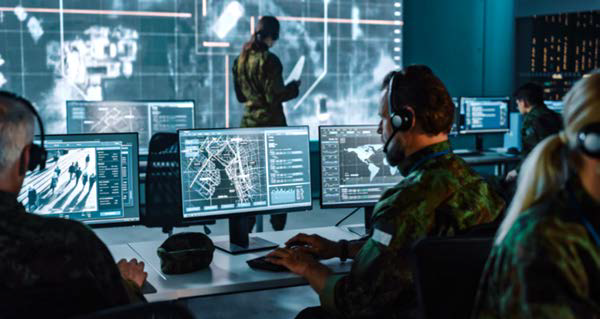The growing role of change-bitrate-on-the-Fly technology
Intelligence, Surveillance and Reconnaissance (ISR) missions are rarely executed in controlled laboratory environments — quite the opposite. These platforms — from airborne drones to terrestrial and underwater remotely piloted vehicles (RPVs) — that carry ISR payloads are often deployed in the harshest of conditions and are connected to users and operators over wildly inconsistent communication networks.

The ability to ensure high-quality images, regardless of network conditions in a theater of operations, has emerged as a critical success factor for ISR activities that depend on video-based intelligence to establish situational awareness and support effective decision-making. This is where Change-Bitrate-on-the-Fly technology comes in.
Change-Bit-Rate-on-the-Fly Technology What Is It + Why Is It Essential To ISR missions?
When talking about video streaming, the focus is often on bitrates, which are measured by considering how many frames are taken each second, along with the size of each frame — the higher the video quality, the more images are needed to process for each second of video, which, of course, results in higher bitrate requirements.
Change-Bit-Rate-on-the-Fly technology is an increasingly important feature for the ISR community as it directly affects the quality and timeliness of tactical field intelligence. Receiving information too late due to network latency, or being unable to understand what is being analyzed because of dropped packets that result in fuzzy or pixelated images, can mean the difference between life and death.
In many ways, the need for Change-Bit-Rate-on-the-Fly capabilities reflects the technological progress that has allowed more sensors with greater capacity to be loaded on ISR platforms — such as drones or helicopters. Innovations around ISR have led to cameras that capture video images in stunning detail and sensors capable of detecting subtle temperature changes in the environment, including ground-penetrating radar. As a result, more information can be shared from a single ISR platform than before.
This does, however, create a challenge.
While devices to capture this wide array of data are becoming increasingly advanced, there are still challenges associated with the wireless networks used to access the data in terms of bandwidth, capability and change. Change- Bit-Rate-on-the-Fly is a technology can help address network constraints by adapting the bitrate as it changes.
The Challenges
The ISR community has done much excellent work in adopting standards across the technical elements needed to capture, share and act on digital intelligence. As a result, most platform and payload technologies can use almost any wireless network in the field to maintain connectivity — and, therefore, the flow of intelligence.
The agility and flexibility that enable drones and other Remotely Piloted Vehicles (RPVs) to use multiple networks means these platforms can dynamically switch from a cellular network to a satellite link and then to a terrestrial mesh network. However, as these platforms shift from one data carrier to another, they will likely experience a difference in bandwidth available to support the data traffic. Sometimes, that delta can be quite significant.
A cellular network might deliver up to 100 megabits in connectivity only to switch to a satellite signal that supports a fraction of that capacity. The other challenge revolves around the roving nature of ISR platforms. The quality and strength of wireless signals are better when platforms are near antennas. The signals weaken as the distance from antennas grows.
While the connectivity environment is highly dynamic – with bandwidth fluctuating from total capacity, only to be cut by half and then a third of capacity — the overall ISR objective of sharing the highest quality image possible remains the same.

That’s why Change-Bitrate-on-the-Fly is a differentiator for IP video applications on ISR platforms. With it, we can make changes dynamically in real-time to ensure the continuity of images at the highest possible quality.
This cannot be emphasized enough, as video in a live environment is crucial for successful ISR. The technology represents a major improvement over previous ISR video capabilities. With Change-Bitrate-on-the-Fly, ISR teams can execute their missions with confidence.
Strategies ForOptimizing IPVideo Capture +Distribution Across ISR Platforms
As tragic as it is, we are in a space where video has become a crucial asset in wartime. Accessing video-based intelligence at the correct time and place is a highly effective method for gaining information about the constantly changing military landscape.
As has been seen since the early days of the Ukrainian invasion, video plays a crucial role in showing hostile troop movements and the general disposition of the arena. Beyond simply capturing video, strategic and tactical decision-makers also benefit from the ability to quickly and appropriately share video-based intelligence. This capability has been critical in optimizing the efficacy of a smaller Ukrainian force by coordinating with global coalition partners.
Technological innovations have widely been credited for helping Ukraine even the odds against Russia’s military might. Internet protocol-based video solutions are increasingly important in getting the best insights to the right people at the right time, especially in the context of C4ISR (Command, Control, Communications, Computers (C4) Intelligence, Surveillance and Reconnaissance).
Advanced C4ISR capabilities offer players in active theaters of operation an opportunity to secure and maintain strategic and tactical advantage through enhanced situational awareness and knowledge of the adversary and environment by shortening the time between sensing and response.
How The War In Ukraine Changed The Role Of Video+ Its Role In Supporting C4ISR
As tragic as it is, we are in a space where video has become a crucial asset in wartime. Accessing video-based intelligence at the right time and place is a highly effective method for gaining information about the constantly changing military landscape.
As we have seen since the early days of the Ukrainian invasion, video plays a crucial role in showing hostile troop movements and the general disposition of the arena. Beyond simply capturing video, strategic and tactical decision-makers also benefit from the ability to quickly and appropriately share video-based intelligence.
Video for ISR has been critical in optimizing the efficacy of a smaller Ukrainian force by coordinating with coalition partners worldwide.
In the past, video applications have been governed by military specifications that were often unique to individual countries or coalitions, which made sharing sensitive intelligence difficult. However, during the war in Ukraine, NATO has set a standard and has been able to communicate essential video intelligence with the Ukrainian military and first responders. It has enhanced the ability to attack a target while protecting — and recovering — from hostile actions.
As important as the video content itself is, there is an even more critical element: metadata. Metadata is the information embedded within video files that allow users to identify the file’s characteristics, making it easier to search, use and manage the video, while confirming the accuracy, credibility and utility of the intelligence captured.
Video metadata includes the date the video was created, the creator’s name, location, date of upload, and even the camera ID. Based on these, and other critical data points, staff and leaders can validate data and ensure proper handling and dissemination of information based on policies designed to protect assets, sources and methods. For this reason, it is important to ensure interoperability at this metadata level.
Commercial-Off-The-Shelf (COTS) standards enhance and broaden the ability to share data as well as improve the effectiveness of Ukraine’s defense. Streaming companies in the commercial space, such as Netflix and Amazon Prime, use video standards to compress data into formats that are streamed live, or packaged for efficient data downloads. Minimizing bandwidth while maintaining the best clarity and picture quality is a crucial business and economic factor.
Also a critical issue in military theaters of operation is the importance for ISR video intelligence to be shared across a range of devices. Compression standards allow ISR infrastructures to be agnostic to the networking and endpoint environment. As a result, while a wide variety of equipment is deployed in the field, the coalition partners supporting Ukraine can share data in a format that anybody can use. Using the standardized codexes used for streaming video makes this manageable.
The Role OfMetadata + StandardsIn Sharing + Controlling Data
In wartime situations, such as the war in Ukraine, it is vital to implement the most stringent security measures to protect video intelligence by securing lines of communication through encryption and other strict security practices, including proper authentication and authorization.
IP video encryption is an essential layer of security that ensures data is safe — even if it is intercepted. There are many sources of video intelligence, including data that civilians provide. Citizens who are unable — or unwilling– to flee are making considerable contributions to intelligence efforts simply by using their cell phones to post videos.
To ensure their safety and ongoing participation in the intelligence-gathering process, measures must be put in place to protect citizens — as well as intelligence operatives, drone operators and military positions. It is especially important now, as Ukraine’s counter insurgence and offensive operations gathers steam.

VITEC is playing an important role in providing military and security forces with the IP video solutions needed to achieve a desired outcome in the conflict. The company is a global technology leader in the IP video space with technologies that capture raw video and convert and compress feeds into data formats that can be encrypted and streamed across the data networks that support military defense efforts.
VITEC technologies are agnostic and highly efficient in terms of bandwidth use. This means video intelligence can easily be uncompressed, replayed, or recorded on any endpoint used by coalition partners across the different wireless networks in the field that support different data rates. In addition, VITEC software can share high-definition video in real time; regardless of the networks involved. Compared to existing offerings in the market, VITEC’s technologies enable twice as much video transmission in the same bandwidth.
www.vitec.com

Mark Rushton
Author Mark Rushton is the Global Defence and Security Leadat VITEC.
VITEC is a global technology leader in the IPTV space, working within the Intelligence, Surveillance, Target Acquisition and Reconnaissance (ISTAR).


